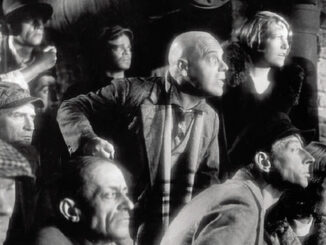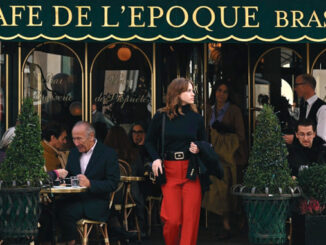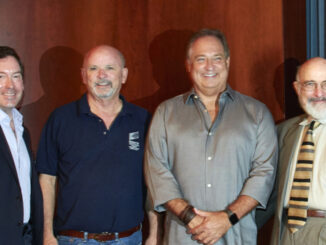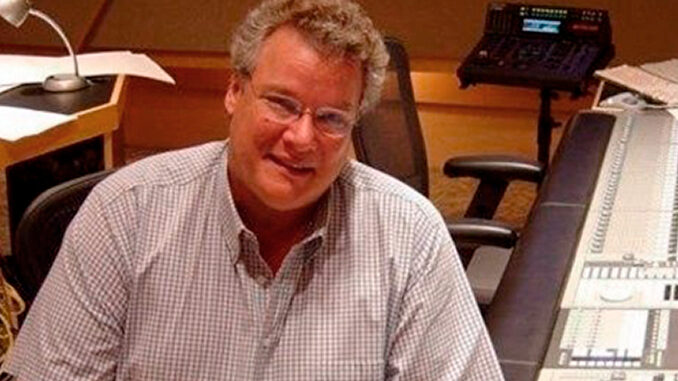
by Mel Lambert
After nearly five decades mixing a large number of successful TV shows and feature films, Tom Fleischman, CAS, will receive the Cinema Audio Society’s highest accolade, its Career Achievement Award, at Saturday’s 56th CAS Awards in Downtown Los Angeles.
“I was surprised and delighted,” Fleischman, a veteran re-recording mixer, said of the award. “I can’t imagine a higher honor for a sound mixer than receiving such an award from the Cinema Audio Society. The recognition of my peers is the greatest gift I could ever receive.”
With a portfolio of over 190 films and more than 20 television projects, the Oscar- and Emmy-winning mixer was born and raised in New York City, and began his career in 1969 as an apprentice film editor. His focus changed in 1971 when he joined Image Sound Studios, where he created a sound effects library, and recorded special effects and Foley. In 1979, he mixed his first commercial feature film, Jonathan Demme’s “Melvin And Howard,” and in 1981 was nominated for an Academy Award for his work, with Richard Vorisek, on Warren Beatty’s “Reds.” Now based at Trans/Audio, he first worked for writer/director Martin Scorsese and picture editor Thelma Schoonmaker, ACE, while handling temp dubs on “Raging Bull,” and then co- mixed “The King of Comedy.” Fleischman’s career-long collaboration with Scorsese continues to this day.
CineMontage: How did you get your start in post-production?
Tom Fleischman: Both of my parents worked in the film industry as I was growing up. My mother was a well-known film editor, Dede Allen, and my dad was Stephen Fleischman, a writer/producer/director of TV documentaries. Naturally, I was drawn to the industry and knew that my career path was going to be in film before I graduated from high school. During the summer of 1969 between high school and college I was an unofficial apprentice editor for [the late] Carl Lerner and Jerry Greenberg, ACE, on “The Angel Levine” and director William Friedkin’s “The Boys In The Band.” Then I attended New York University School of the Arts as an undergraduate film student before dropping out and getting my first real job in post-production. I spent 12 years at Trans/Audio working with my mentor/guru/sensei Dick Vorisek, a legendary New York mixer.
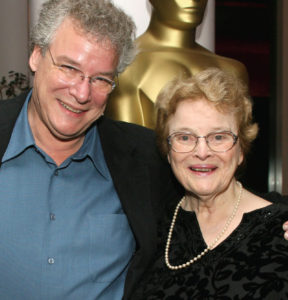
Motion Picture and Sciences’ tribute to her in New York in 2007.
Photo by Alex Oliveria/Startraksphoto for AMPAS Copyright AMPAS
What specific skills do you think that you bring to the function of a re-recording engineer? Technical aptitude? A collaborative disposition?
It’s certainly not technical aptitude. I was, and continue to be, clueless about how any of the equipment actually works. The most important “skill” that a re-recording mixer must have is an innate sense of story and dramatic structure; a sense of when a scene was playing well and when it wasn’t – and the ability to diagnose and solve story problems that are sound-related.
Being based for most of your career in New York – recently at Soundtrack F/T in Chelsea – do you perceive a difference in mixing philosophies – or even “styles” – between your East and West Coast colleagues?
There has always been a difference between the way we work in New York and the way things work in Hollywood. The New York film community is very small and has always been close-knit and independent. We don’t have major studios. When I started mixing, Hollywood always used three-person crews, each mixer handling either dialogue, music, or sound effects. Here in New York, I learned to mix by myself, handling all the tracks – there were not enough mixers here to do it the Hollywood way. It wasn’t until many years into my career that I had the opportunity to work in Hollywood with a second mixer. By that time Hollywood’s traditional three-man crews had shrunk to mostly two-man crews. But all that said, the philosophy of mixing was really the same: we all mixed a scene at a time, and the goal on both coasts was to make the scenes play.
How do you set up for a mixing or re-recording project? What do you want to hear from the director and maybe the picture editor, in terms of overall sound direction?
I usually don’t get involved until the picture editing process is nearly complete, and I rarely discuss overall sound direction before the mix. I watch the film, either a screening, or I do a temp mix. The film tells me what it wants to be. Occasionally, I will go to a spotting session with the director and/or editor, but that is very rare.
Is your approach different when you are mixing a stereo soundtrack, compared to a 5.1/7.1-channel TV/streaming or theatrical release?
No, my approach is the same. When I began mixing in the mid-Seventies, most films were still being mixed in mono on a single three-track master; mixing in Dolby Stereo was a luxury. But things quickly evolved and, after a few years of mixing exclusively in mono, four-channel (LCRS) Dolby Stereo became the norm, then Dolby SR, which was still a four-channel analog system. It wasn’t until almost 20 years into my career that films began routinely mixing in 5.1, and 7.1, and Dolby Atmos only evolved over the last decade. During all this time my preference has been to always mix in the largest format available, and then downmix for smaller formats.
Have you had much experience mixing in Dolby Atmos and related immersive-sound formats? What creative options do these formats offer you as a mixer?
I’ve really only begun to scratch the surface with Atmos in the past year or two. I’ve mixed two features and one TV series in Atmos. Immersive formats offer great opportunities to help put the audience into the picture, but I also think we have to be careful not to use them just for the sake of using them. Moving sounds around the theater can help the audience understand the geography of a scene, but it can also be utterly distracting and take the audience out of the story.
What do you discuss with the supervising sound editor and his/her editorial team, in terms of deliverables to the dubbing stage?
I like to have a conversation with both the supervising sound editor and the music editor about what will be delivered to the stage. I do not like surprises, particularly when it comes to the music. I also like to discuss with the scoring mixer, if there is a composed score, about how the score will be broken down into separate stems. Dialogue is fairly straightforward. I like to know how much ADR there will be and how it will be prepared in relation to the other dialogue tracks. I like to know how much group ADR to expect and whether it will come with the dialogue pre-dub or with the final mix. I very rarely mix alone anymore, so sound effects nowadays are normally pre-dubbed and handled in the mix by a second mixer or by the FX editors.
For dialog elements, do you prefer to receive the original production track, in addition to edited/processed tracks and looped lines, to provide options during the mix?
Tom Fleischman: Yes, it is of utmost importance for the dialogue editor to provide the original, unprocessed recordings in the dialogue session adjacent to any processed tracks. It’s very easy for an editor working without any of the other elements of the track playing to go too far when processing. I’d rather have more noise, especially when it’s justified by the picture, than an over-processed track where the voice quality has been degraded and the performance negatively affected. My advice is to take out unwanted noise editorially, if possible, before applying any signal processing to the track, which is something that is best left for the final mix. With regard to ADR, the original production track should always be included in the session; often unused outtakes can be used in place of sync production to solve many problems that might otherwise require ADR. In my experience most directors would much prefer using original performances over ADR, unless performance was the reason for doing the ADR.
Do you have a favorite mixing platform? Is it a matter of familiarity and/or specific functions, for example? Or can you get a successful mix from virtually anything put in front of you?
I like the challenge of working on an unfamiliar desk. Yes, I can always get a good mix no matter what kind of desk I’m working on, but generally it takes more time to conquer the learning curve. I’ve eventually come to love any of the desks that I used for extended periods, but technology marches on. I’m now coming to terms with the Avid S6 desk on which I’ve mixed two features. I’m loving many things about the S6, but it’s a steep learning curve.
You have mixed several soundtracks with strong musical components, including “Living in the Material World: George Harrison” (2011) and “Rolling Thunder Revue: A Bob Dylan Story” (2019). Are there major challenges while working on such projects?
Documentary projects are always simpler than narrative films; there are always fewer tracks. The fact that they are documentaries makes dealing with badly recorded production tracks much easier. For music, I always prefer to have separate stems, since anything that gives me more control over balances in the mix is a big plus.
You have enjoyed a long and successful collaboration with director/producer/writer Martin Scorsese, dating from “The King of Comedy” (1982). How did that connection start?
I first met Marty in my short-lived college year. But our professional relationship really didn’t begin until many years later when Thelma Schoonmaker brought in a scene from “Raging Bull,” and I was assigned to do a quick temp mix of dialogue and music. She came back about a week later with another scene and told me that Marty really liked what I had done on the first one. That was the start – just those two scenes. “Raging Bull” went on to be mixed in Hollywood but, despite winning an Oscar for Best Sound, Marty never mixed in Hollywood again. His next film was “King of Comedy” and he had hired Dick Vorisek to mix it. Sadly, Dick had suffered a heart attack and was under doctor’s orders to work no overtime, so I was brought in as a second mixer to work with him. But Marty has never been a morning person and he would come in later in the day and would want to mix into the evening. I’ve worked on all of his films ever since.
After working with Martin Scorsese on so many film and TV projects, have you developed a shorthand with him on the dubbing stage? How does he communicate his ideas to you?
I think I understand his style and his sensitivities; I think he trusts me. He is very communicative in the mix – he knows exactly what he wants, and won’t let it go until he gets it. That said, he also likes to experiment and is fun to work with. He is keen on transitions – transitions between scenes but particularly the musical transitions; we spend more time on those than anything else.
Scorsese’s latest film, “The Irishman,” is long and complex, moving through several decades as it follows the fate of various protagonists. Did you use much processing to age the voices of lead actors?
Our main directive was to keep it quiet when it needed to be quiet, and to keep it simple. No big splashy sound effects; very little Foley. No heavy processing on the dialogue; keep the quality of the voices pure. Keep music mostly front and center. With regard to the de-ageing, we did very little. We did do some experimentation with plug-ins and pitch shifting but, in the end, it was mostly done by dialogue editor Phil Stockton by cleaning out as much of Bob DeNiro’s heavy breathing and vocalizations between the words as he could, and then doing a very slight pitch change.
As with the majority of Scorsese’s productions, music figures strongly within “The Irishman’s” soundtrack. How do you balance the musical elements against dialog and sound effects?
The music should tell you how it should be played. It can’t overwhelm the dialogue, but it also needs to accent where appropriate. The pre-recorded songs were mostly kept front and center. With Robbie Robertson’s score I opened it up more and used the lead harmonica as an Atmos object, bringing it off the screen. The prime directive was to keep the scenes quiet and intimate, with no distractions from the performances.
Is there one “Magic Tool” or process that you hope somebody might develop to make your life easier on the stage?
I’ve always wished someone would invent a device that I could put on my head and think about how the film should sound. And it would automatically come out that way!
How do you unwind after a busy day on the dubbing stage? Do you have any hobbies? Or music appreciations?
When I was younger I did things like joining the volunteer fire department in my town, and flying private airplanes all over the place. But now I play my guitars badly, and in the past few years I’ve started playing chess rather seriously in rated tournaments. I’ve also become very active in Local 700, serving on the Board of Directors, and also in the Cinema Audio Society as a board member.



